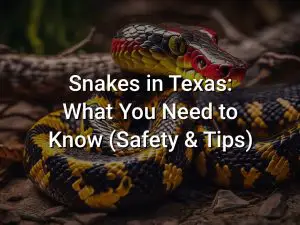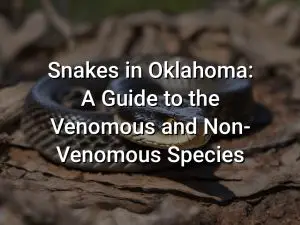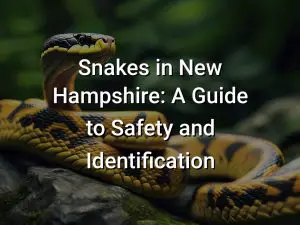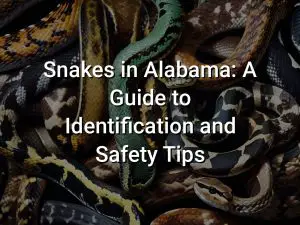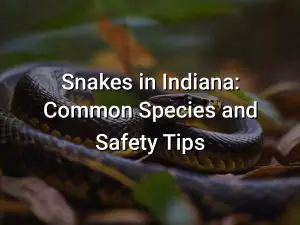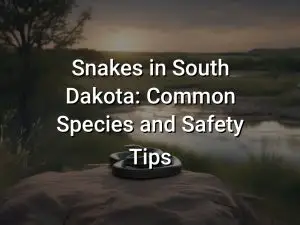Snakes in Maryland: Common Species and Safety Tips

Snakes in Maryland may not be the first thing that comes to mind when you think of this picturesque state, but it is actually home to a wide variety of snake species. From the colorful scales of the Eastern Rat Snake to the venomous presence of the Copperhead Snake, Maryland offers a fascinating array of snakes that call it home.
But fear not! While encountering a snake in the wild can be a bit intimidating, it’s important to remember that most snakes in Maryland are harmless and play a vital role in the ecosystem. In this article, we’ll explore the common species of snakes in Maryland, providing you with interesting insights into their habits and appearances. We’ll also share some safety tips to ensure that your encounters with these reptiles are both educational and enjoyable. So, let’s dive in and learn more about the snakes that slither through Maryland!
Quick Links
Common Species of Snakes in Maryland
Maryland is home to a variety of snake species, each with its own unique characteristics and habitat preferences. While some snakes in Maryland are harmless, others can be venomous. Here are some of the common snake species you may encounter in Maryland:
Eastern Rat Snake: Also known as the black rat snake, this species is non-venomous and can grow up to six feet long. It is typically black or dark brown with white or yellow markings.
Milk Snake: Milk snakes are non-venomous and have distinctive red, black, and yellow banding on their bodies. They usually grow to be around two to three feet long.
Northern Water Snake: These water snakes are non-venomous and have a dark brown or gray body with reddish-brown or black markings. They are often found near bodies of water.
Copperhead Snake: The copperhead is one of Maryland’s venomous snake species. It has a copper-colored head and light brown or tan body with dark hourglass-shaped markings.
Eastern Garter Snake: Garter snakes are harmless and commonly found in Maryland. They have a green or brown body with three yellow stripes running down their back.
Eastern Ribbon Snake: Ribbon snakes are non-venomous and have a slender body with a dark green or brown color and a yellow or white stripe running down the length of their body.
Black Rat Snake: Similar in appearance to the Eastern Rat Snake, black rat snakes are non-venomous and have a black or dark brown body with white or yellow markings.
Eastern Worm Snake: These small and harmless snakes have a dark brown or black body and are often mistaken for earthworms due to their size and appearance.
Timber Rattlesnake: The timber rattlesnake is Maryland’s largest venomous snake species. It has a thick body with a brown or gray color and dark blotches along its length. It also has a rattle on its tail.
It’s important to remember that most snakes are not aggressive and will only bite if they feel threatened. If you encounter a snake, it is best to give it space and avoid disturbing it.
Eastern Rat Snake
The Eastern Rat Snake, also known as the Black Rat Snake, is a common species of snake found in Maryland. It is one of the largest snake species in the state, reaching lengths of up to 7 feet. The Eastern Rat Snake is non-venomous and poses no threat to humans.
These snakes are typically black or dark brown in color with some individuals having light-colored scales on their belly. They have a slender body and keeled scales, which give them a rough appearance. Their heads are slightly larger than their necks, and they have round pupils.
The Eastern Rat Snake is an excellent climber and can often be found in trees or other elevated areas. They are proficient hunters and consume a diet consisting primarily of rodents, such as mice and rats. They are also known to eat birds, eggs, and other small animals.
Despite their intimidating size, Eastern Rat Snakes are generally docile and will try to escape when confronted. However, they may bite if they feel threatened or are cornered. It is important to remember that they are a protected species in Maryland and should not be harmed or killed.
If you encounter an Eastern Rat Snake, the best course of action is to leave it alone and allow it to move away on its own. Keep a safe distance and do not attempt to handle or provoke the snake. Snakes play an important role in the ecosystem by helping to control rodent populations, so it is best to appreciate them from a distance.
Milk Snake
The Milk Snake is a non-venomous snake species found in Maryland and throughout North America. It is known for its vibrant and colorful appearance, often featuring red, black, and yellow bands or blotches on its smooth scales.
Milk Snakes are constrictors, meaning they kill their prey by wrapping their bodies around it and squeezing until the animal suffocates. They primarily feed on small mammals, such as mice and voles, but they also eat birds, eggs, and other reptiles.
Despite their name, Milk Snakes do not produce milk. The name “milk” comes from the mistaken belief that the snakes would suck the milk from cows. In reality, they were often found near barns and farmhouses where mice and other small rodents were abundant.
Milk Snakes are generally docile and not aggressive towards humans. However, if threatened, they may hiss, strike, or release a foul-smelling secretion as a defense mechanism.
If you encounter a Milk Snake in Maryland, it is important to remember that they are harmless. Appreciate their beauty from a safe distance and allow them to continue their natural behaviors. It is always recommended to leave snake handling to trained professionals to ensure both your safety and the well-being of the snake.
Northern Water Snake
The Northern Water Snake is a common snake species found in Maryland’s waterways. It is a non-venomous snake and is often mistaken for the venomous Water Moccasin or Cottonmouth due to its similar appearance.
The Northern Water Snake can grow up to 3-4 feet long and has a thick body with dark-colored scales. Its coloration can vary, but it is usually dark brown or grey with reddish-brown or black markings on its back.
This snake is most commonly found near bodies of water such as rivers, lakes, ponds, and marshes. It is an excellent swimmer and can often be seen basking on rocks or logs near the water’s edge.
The Northern Water Snake feeds on a diet of fish, frogs, and small mammals. It is a non-aggressive snake but may bite if threatened or cornered. However, its bite is not venomous and poses no serious threat to humans.
If you encounter a Northern Water Snake, it is best to observe it from a safe distance and not attempt to handle or provoke it. These snakes play an important role in the ecosystem by controlling populations of small mammals and maintaining the balance of the aquatic ecosystem.
Remember, snakes are a natural part of the environment, and it is important to respect and coexist with them. If you have concerns about snakes on your property, it is best to contact a professional wildlife removal service to safely and humanely address the issue.
Copperhead Snake
The Copperhead Snake (Agkistrodon contortrix) is one of the venomous snake species found in Maryland. It is named for its copper-colored head and is known for its distinctive hourglass-shaped markings on its body. Copperhead snakes are typically found in wooded areas, rocky hillsides, and near water sources.
Copperheads are relatively small snakes, growing to an average length of 2 to 3 feet. They have stout bodies and triangular-shaped heads. Their bites can be dangerous, as their venom contains toxins that can cause severe pain, swelling, and tissue damage.
Despite their venomous nature, copperhead snakes are generally not aggressive and will typically try to avoid human contact. They rely on their camouflage to blend in with their surroundings, making them difficult to spot.
If you encounter a copperhead snake, it is important to avoid provoking or approaching it. Give the snake a wide berth and ensure that children and pets are kept at a safe distance. If you are bitten by a copperhead snake, seek immediate medical attention. Do not attempt to handle or capture the snake, as this can increase the risk of additional bites.
To reduce the likelihood of encountering a copperhead snake, take precautions when spending time in snake habitat. Wear long pants and boots or closed-toe shoes when walking through wooded areas or tall grass. Be cautious when reaching into rocky or brushy areas, as snakes may be hidden in these locations.
It is also important to be aware of your surroundings and use caution when exploring snake habitats. Snakes are generally more active during warmer months, so exercise extra vigilance during this time. By being aware of the common species of snakes in Maryland and following safety tips, you can minimize the risk of snake encounters and ensure your safety in snake-prone areas.
Eastern Garter Snake
The Eastern Garter Snake (Thamnophis sirtalis) is one of the most common snake species found in Maryland. It is a non-venomous snake that can vary in coloration, but is typically green or brown with three yellow stripes running down its body.
Garter snakes are found in a variety of habitats, including forests, grasslands, wetlands, and suburban areas. They are often found near water sources, such as ponds and streams.
These snakes are generally harmless and prefer to avoid human contact. They are also beneficial to have around as they help control populations of small mammals and insects. However, if threatened or cornered, they may release a foul-smelling musk or bite in self-defense.
Eastern Garter Snakes are active during the day and are often seen sunning themselves on rocks or logs. They are also good swimmers and climbers. Their diet consists of small prey, such as frogs, toads, worms, and small mammals.
If you encounter an Eastern Garter Snake, it is best to observe it from a distance and give it space. Do not attempt to handle or remove the snake unless you are trained and experienced in snake handling. Remember, these snakes are beneficial to the ecosystem and play an important role in maintaining a healthy balance in nature.
Eastern Ribbon Snake
The Eastern Ribbon Snake is a common species of snake found in Maryland. It is known for its slender body and distinctive black stripes running along its sides. The snake can grow up to 2 feet in length.
The Eastern Ribbon Snake is often found near water sources such as streams, ponds, and marshes. It is a non-venomous snake and poses no threat to humans. It primarily feeds on small amphibians and insects.
When encountered, the Eastern Ribbon Snake is typically timid and will try to escape rather than confront humans. If cornered or threatened, it may release a musky smell as a defense mechanism. It is important to remember that snakes play a crucial role in the ecosystem and should not be harmed.
If you come across an Eastern Ribbon Snake in Maryland, it is best to observe it from a safe distance and allow it to continue on its way. Remember to respect wildlife and their habitats while enjoying the outdoors.
Black Rat Snake
The Black Rat Snake, also known as the Eastern Rat Snake, is one of the most commonly encountered snake species in Maryland. As its name suggests, it is primarily black in color, with some individuals having white or yellow markings on their belly.
Black Rat Snakes are non-venomous and are beneficial to have around, as they help control rodent populations. They are excellent climbers and are often found in trees, barns, and other structures where they can hunt for prey.
These snakes can grow to be quite large, with some reaching lengths of up to 8 feet. Despite their intimidating size, they are generally shy and will try to escape when encountered by humans. If cornered or threatened, they may vibrate their tail and strike, but their bites are nonvenomous and harmless.
It is important to remember that snakes, including the Black Rat Snake, play an important role in maintaining a balanced ecosystem and should not be harmed or killed unnecessarily. If you encounter a Black Rat Snake, it is best to give it space and allow it to continue on its way.
If you have a rat or mouse problem, consider implementing rodent control measures to deter them from your property, rather than relying on snakes to do the job.
Eastern Worm Snake
The Eastern Worm Snake (Carphophis amoenus) is a small, non-venomous snake commonly found in Maryland. It is a slender snake with a shiny and smooth appearance, typically measuring between 7 and 11 inches in length. The coloration of the Eastern Worm Snake can vary, but it is generally brown or gray with a pale or pinkish belly.
This species is primarily found in wooded areas, forests, and wetlands, where it burrows into the soil and leaf litter. It is commonly encountered in gardens, lawns, and other areas with loose soil, as it feeds primarily on earthworms and soft-bodied invertebrates.
The Eastern Worm Snake is relatively secretive and nocturnal, often hiding under rocks, logs, and other debris during the day. It is a non-aggressive species and will typically attempt to burrow or flee if disturbed. However, it may occasionally emit a musky odor as a defensive mechanism.
Although the Eastern Worm Snake is harmless to humans and plays a beneficial role in controlling pest populations, it is often mistaken for the venomous Eastern Coral Snake due to their similar coloration and markings. It is important to note that the Eastern Worm Snake has a small, blunt tail compared to the Coral Snake’s longer, pointed tail.
If you encounter an Eastern Worm Snake, it is best to admire it from a distance and avoid handling it. Remember, snakes play a vital role in maintaining the ecological balance, and it is always best to respect and appreciate them from afar.
Timber Rattlesnake
The timber rattlesnake (Crotalus horridus) is a venomous snake species found in Maryland. It is one of the largest venomous snakes in the state, reaching lengths of up to 6 feet. The timber rattlesnake is known for its distinctive rattle, which it uses as a warning signal when threatened.
This species is typically found in rocky, forested areas with ample cover for hiding and hunting. They are most active during the warmer months and tend to hibernate during the colder winter months.
Timber rattlesnakes primarily feed on small mammals such as mice, rats, and squirrels. Their venom is used to immobilize their prey and aid in digestion.
If you encounter a timber rattlesnake in Maryland, it’s important to keep a safe distance and avoid provoking the snake. Give it space to retreat and do not attempt to handle or kill it. These snakes are generally not aggressive unless threatened, and most bites occur when people try to handle or kill the snake.
If you are bitten by a timber rattlesnake, seek immediate medical attention. It is important to stay calm and minimize movement to slow the spread of venom. Do not attempt to suck out venom or use a tourniquet.
Protecting the habitat of timber rattlesnakes is crucial for their survival. If you come across a timber rattlesnake in the wild, appreciate it from a safe distance and allow it to continue its important role in the ecosystem.
Safety Tips for Encountering Snakes
Encountering snakes can be unnerving, but it’s important to remember that most snakes in Maryland are harmless and play a crucial role in the ecosystem. Here are some safety tips to keep in mind when encountering snakes:
- Stay Calm: It’s natural to feel scared or startled when you come across a snake, but try to remain calm. Most snakes will go about their business and won’t harm you if left alone.
- Keep Your Distance: Give snakes plenty of space. Back away slowly and avoid making sudden movements or loud noises that may startle them.
- Don’t Touch or Handle Snakes: Even non-venomous snakes can bite if they feel threatened or cornered. Avoid touching or attempting to handle snakes unless you are a trained professional.
- Watch Your Step: Keep an eye out for snakes when walking in areas with tall grass, logs, rocks, or brush. Be cautious when stepping over these obstacles and watch where you place your hands and feet.
- Wear Appropriate Footwear: When hiking or exploring outdoors, wear closed-toe shoes or boots to help protect your feet from snake bites.
- Be Vigilant Around Water: Snakes are often found near bodies of water, so be particularly cautious around lakes, ponds, streams, and marshy areas.
- Teach Children about Snake Safety: If you are with children, educate them about snake safety and the importance of respecting wildlife. Encourage them to stay calm and avoid touching snakes.
- Know the Venomous Species: Familiarize yourself with the venomous snakes in Maryland, such as the Copperhead snake, and learn to recognize their markings. If you spot a venomous snake, keep a safe distance and contact local animal control or a wildlife professional for assistance.
- Report Snake Sightings: If you come across an unusual or potentially dangerous snake, report the sighting to your local animal control or wildlife agency. They can provide guidance and ensure the safety of both the public and the snake.
By following these safety tips and respecting snakes and their habitats, you can coexist peacefully with these fascinating creatures.
Conclusion
Now that you are familiar with the common species of snakes in Maryland and have learned some important safety tips for encountering snakes, you can feel more confident and prepared when spending time in snake-prone areas. Remember, snakes are an important part of the ecosystem and generally want to avoid human interaction. By staying alert, giving snakes their space, and following the safety guidelines outlined above, you can coexist with these fascinating creatures while ensuring your own well-being.
So, go out and enjoy nature in Maryland, knowing that you have the knowledge to safely navigate snake encounters. With a little awareness and respect, you can appreciate the biodiversity of the region and reduce any unnecessary fear or anxiety about snakes. Stay safe and have a wonderful time exploring the great outdoors!

